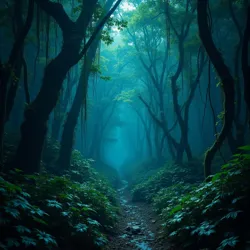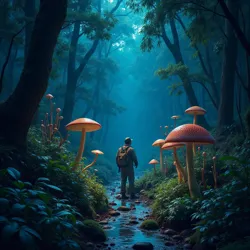Madlands of Tla'tlaqixi
 A rare photograph capturing the ethereal bioluminescence of the Night-Blooming Consciousness Vine in the depths of Tla'tlaqixi
A rare photograph capturing the ethereal bioluminescence of the Night-Blooming Consciousness Vine in the depths of Tla'tlaqixiThe Madlands of Tla'tlaqixi remain one of the most enigmatic and dangerous regions in Mesoamerica, a vast tract of marshland and twisted rainforest that harbors countless biological and anthropological mysteries. This treacherous landscape, whose name translates to "the Shunned Ones' slough" in Classical Nahuatl, continues to challenge modern scientific understanding while preserving ancient secrets of the Maqamiztleca people who sought refuge here centuries ago.
Today's Featured Article: The Language of Shared Hallucinations
The indigenous peoples of Tla'tlaqixi have developed a unique form of communication that transcends conventional linguistic boundaries. Known as Xochitl-speech, this remarkable phenomenon combines vocalized language with shared hallucinatory experiences, facilitated by carefully controlled doses of local psychoactive substances. Recent studies by the Institute of Ethnolinguistic Phenomena have documented over three hundred distinct "vision-words" that can only be fully understood when experienced in an altered state of consciousness.
The development of Xochitl-speech appears to be intrinsically linked to the region's unusual concentration of psychoactive flora and fauna. Practitioners describe experiencing synchronized visual and auditory hallucinations that convey complex concepts impossible to express through ordinary language. The practice has drawn significant attention from cognitive scientists and anthropologists, though many researchers have reported experiencing persistent psychological effects after attempting to learn the basics of this unique communication system.
Current Research and Expeditions
 Members of the Phosphorescent Fungi Research Initiative documenting a newly discovered species of consciousness-altering mushroom
Members of the Phosphorescent Fungi Research Initiative documenting a newly discovered species of consciousness-altering mushroomThe Department of Anomalous Biology has recently established a permanent research station in the Whisperleaf Valley to study the unusual symbiotic relationships between local plant species and the indigenous fungal networks. Of particular interest is the apparent ability of certain fungal species to facilitate communication between different plant species, leading to coordinated behavioral changes that defy current biological understanding.
Archaeological teams working in the Black Cenote District have uncovered new evidence suggesting that the original Maqamiztlec settlers deliberately cultivated specific combinations of psychoactive plants to create "consciousness zones" used in religious ceremonies. These zones appear to have been carefully maintained through sophisticated agricultural practices that may have contributed to the region's current biological peculiarities.
Did You Know...
The Sacred Groves of Eternal Dreaming contain trees that appear to respond to human brain activity, with some specimens reportedly changing their chemical composition to produce specific psychoactive compounds based on the emotional states of nearby humans.
Local shamans have developed immunity to several typically lethal neurotoxins, including those produced by the notorious Schzächt's Arrow-Frog, through a complex process of gradual exposure beginning in childhood.
The Tla'tlaqixi Giant Centipede exhibits signs of rudimentary collective intelligence when gathering in large groups, with swarms displaying behavior patterns that suggest some form of shared consciousness.
Recent Discoveries
The ongoing Mycelial Mapping Project has revealed an extensive underground network of fungal connections linking various archaeological sites throughout the region. These discoveries have led to new theories about the role of fungal networks in the mysterious disappearances that have plagued the area, including the infamous Vanishing of the Morton Team.
Researchers from the Institute of Consciousness Studies have documented unusual patterns of synchronized hallucinations among unrelated individuals in certain areas of the madlands, leading to speculation about the existence of localized "reality distortion fields" created by unique combinations of local flora.
Environmental Concerns
Conservation efforts in Tla'tlaqixi face unique challenges due to the complex interconnections between the region's biological and psychological phenomena. The Environmental Protection Coalition has expressed concern about the impact of increased research activity on delicate ecosystems, particularly in areas where rare combinations of species create unique psychoactive effects.
The Council of Indigenous Knowledge has called for stricter regulations on scientific research in sacred areas, citing the need to protect both the physical environment and the psychological well-being of local communities. These concerns have been amplified by several incidents of researchers experiencing severe psychological disturbances after prolonged exposure to certain areas of the madlands.
Cultural Significance
The madlands continue to play a crucial role in indigenous spiritual practices, with local shamans maintaining ancient traditions that incorporate the region's unique biological properties. The Festival of Dissolving Minds, held annually during the rainy season, attracts practitioners from throughout the region who seek to experience the powerful consciousness-altering effects of carefully prepared botanical combinations.
Traditional knowledge of the area's psychoactive substances is carefully guarded by indigenous communities, who express concern about potential exploitation by pharmaceutical companies and amateur ethnobotanists. The Council of Eternal Remembrance works to preserve this knowledge while protecting it from misuse.
Current Events
Recent satellite imagery has revealed previously unknown geometric patterns in the forest canopy, suggesting the presence of ancient architectural structures hidden beneath centuries of growth. These discoveries have prompted renewed interest in the Archaeological Mysteries of Tla'tlaqixi.
The International Botanical Congress has designated several areas within Tla'tlaqixi as priority research zones due to their unprecedented concentration of previously unknown plant species. However, access to these areas remains strictly controlled due to safety concerns and respect for indigenous sovereignty.
See Also
References
Primary sources include the extensive documentation from the Quine Expedition, supplemented by indigenous oral histories and ongoing scientific research. The Tla'tlaqixi Historical Archive maintains the most complete collection of documents relating to the region, though access to certain materials remains restricted due to their sensitive nature.
The complexity of studying Tla'tlaqixi is compounded by the psychological effects experienced by researchers, leading to questions about the reliability of some historical accounts. Modern research efforts increasingly employ remote sensing and automated data collection to minimize human exposure to the region's more dangerous phenomena.